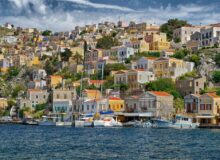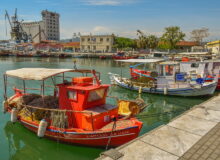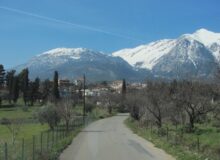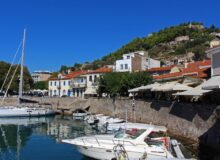The See Greece guide to Naxos in the Cyclades with a brief history and travel information on how to get there by ferry or by air and what to see and do.

Introduction
Naxos is the largest and most fertile island in the Cyclades, a stunning archipelago in the heart of the Aegean Sea. Known for its long sandy beaches, charming mountain villages, and rich history, Naxos offers a perfect blend of relaxation, adventure, and cultural exploration. Unlike some of its more tourist-heavy neighbors like Santorini and Mykonos, Naxos retains an authentic Greek island vibe while still offering excellent amenities for travelers.
Whether you’re looking for a beach getaway, a hiking adventure, or a deep dive into Greek mythology and history, Naxos has something for everyone.
Where is Naxos Located?

Naxos is part of the Cyclades island group in the Aegean Sea, southeast of mainland Greece. It lies between the islands of Paros (to the west) and Mykonos (to the northeast). The island’s capital, Naxos Town (Chora), is a major port and the first glimpse visitors get when arriving by ferry.
Key Distances:
– Athens to Naxos: ~175 km (109 miles)
– Santorini to Naxos: ~80 km (50 miles)
– Mykonos to Naxos: ~40 km (25 miles)
Naxos is large enough (429 km²) to offer diverse landscapes—from golden beaches to rugged mountains—but small enough to explore in just a few days.

A Brief History of Naxos
Naxos has a long and fascinating history, dating back to ancient times.
Ancient & Mythological Roots
– According to Greek mythology, Naxos was where Theseus abandoned Ariadne after she helped him escape the Minotaur’s labyrinth in Crete. The god Dionysus later found and married her here.
– The island was a major center of Dionysian worship, and wine production has been a tradition for millennia.
– In the 6th century BC, Naxos was a powerful city-state and a key player in the Cycladic civilization.
Medieval & Venetian Rule
– During the Middle Ages, Naxos came under Venetian control (13th–16th centuries). The Venetians built impressive castles and towers, many of which still stand today.
– The island was later ruled by the Ottomans before becoming part of modern Greece in the 19th century.
Modern Naxos
Today, Naxos is a thriving island with a strong agricultural economy (famous for its potatoes, cheese, and wine) and a growing tourism industry.

What to See & Do on Naxos
1. Explore Naxos Town (Chora)
The island’s capital is a maze of whitewashed alleys, Venetian mansions, and lively tavernas. Key sights include:
– Portara (The Great Door): The iconic marble doorway of an unfinished 6th-century BC temple of Apollo, standing on a small islet connected to the town. It’s the perfect spot for sunset views.
– Kastro (Venetian Castle): A 13th-century fortress built by the Venetians, now home to museums, churches, and boutique shops.
– Archaeological Museum: Housed in a former Jesuit school, it displays artifacts from Naxos’ ancient past.
2. Relax on Naxos’ Best Beaches
Naxos has some of the best beaches in the Cyclades, with golden sand and crystal-clear waters. Top picks:
– Agios Prokopios – Family-friendly, shallow waters, and beach bars.
– Plaka Beach – Long, sandy, and less crowded, perfect for relaxation.
– Agia Anna – A quieter alternative to Agios Prokopios, with great seafood tavernas.
– Mikri Vigla – A windsurfing hotspot with two distinct beaches (one calm, one windy).

3. Visit Traditional Mountain Villages
Naxos’ inland villages offer a glimpse into authentic island life:
– Apeiranthos – A picturesque village with marble-paved streets and a small folklore museum.
– Filoti – The largest mountain village, home to the Panagia Filotitissa Church and great hiking trails.
– Halki (Tragea Valley) – A charming village with neoclassical mansions and the Vallindras Distillery, where the local citron liqueur (Kitron) is made.
4. Discover Ancient Temples & Ruins
– Temple of Demeter (Gyroula) – A well-preserved 6th-century BC temple dedicated to the goddess of agriculture.
– Kouros Statues (Melanes & Apollonas) – Unfinished ancient marble statues abandoned in quarries.

5. Hike to Mount Zas (Zeus)
According to myth, Zeus was raised in a cave on Mount Zas, the highest peak in the Cyclades (1,004m). The hike offers breathtaking views of the island.
6. Taste Local Naxian Cuisine
Naxos is a food lover’s paradise. Must-try dishes:
– Graviera Naxou – A famous local cheese.
– Potato-based dishes (Naxos grows its own delicious potatoes).
– Kitron Liqueur – Made from citron leaves, available in sweet and dry varieties.
7. Day Trips to Nearby Islands
From Naxos, you can easily visit:
– Paros (30 min by ferry)
– Mykonos (1–2 hours by ferry)
– Santorini (2–3 hours by ferry)

How to Get to Naxos
By Air
– Naxos Island National Airport (JNX) has seasonal domestic flights from Athens (45 min) operated by Olympic Air and Sky Express.
– International travelers typically fly to Athens International Airport (ATH) and then take a connecting flight.
By Ferry
Naxos is well-connected by ferry from Athens and other Cycladic islands:
– From Athens (Piraeus Port):
– Fast ferries (3–4 hours, operated by Seajets, Golden Star Ferries)
– Conventional ferries (5–6 hours, operated by Blue Star Ferries)
– From Santorini, Mykonos, or Paros:
– Frequent high-speed ferries (1–2 hours)
Tips for Ferry Travel:
– Book tickets in advance in peak season (July–August).
– Arrive early to secure a good seat.
– Choose a fast ferry for quicker travel but expect higher prices.

Final Tips for Visiting Naxos
– Best time to visit: May–June or September–October for fewer crowds and pleasant weather.
– Getting around: Rent a car, ATV, or scooter to explore remote beaches and villages. Public buses are reliable but limited.
– Currency: Euro (€). Credit cards widely accepted, but cash is useful in small villages.
Conclusion
Naxos is a gem in the Cyclades, offering a perfect mix of history, nature, and relaxation. Whether you spend your days lounging on Plaka Beach, hiking through mountain trails, or exploring ancient ruins, Naxos promises an unforgettable Greek island experience.























